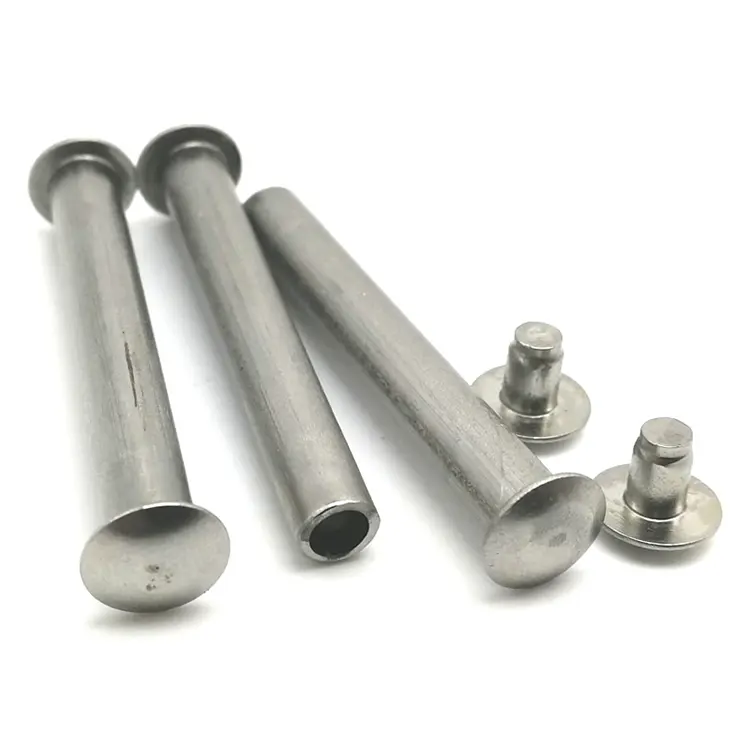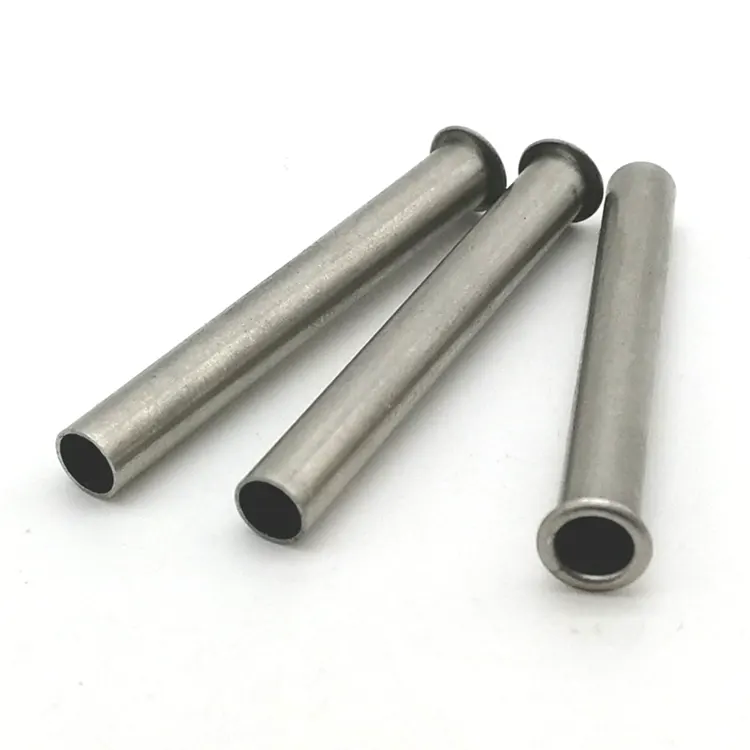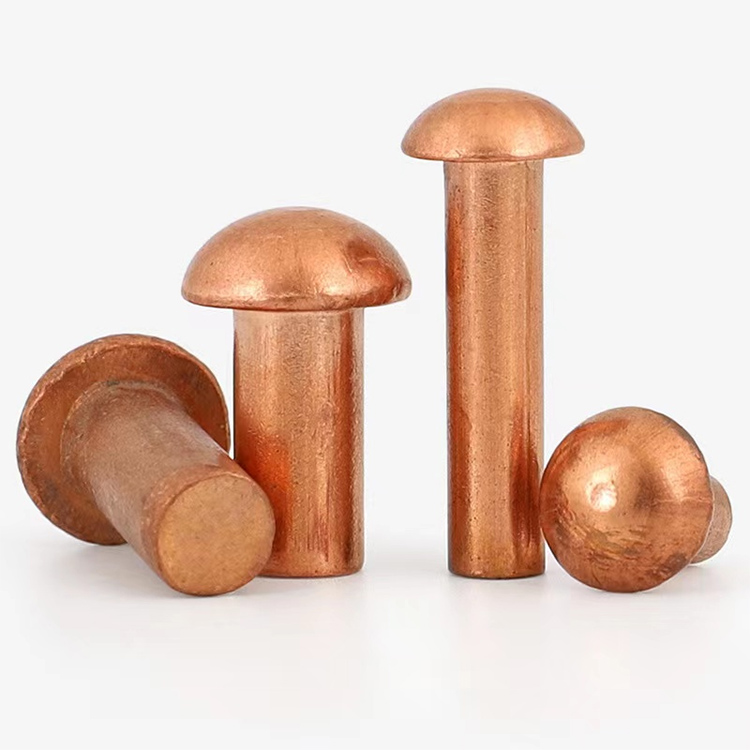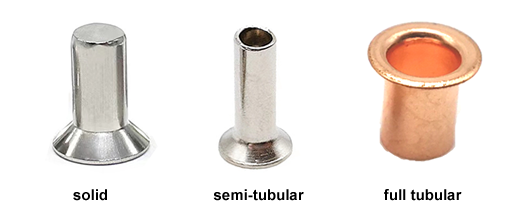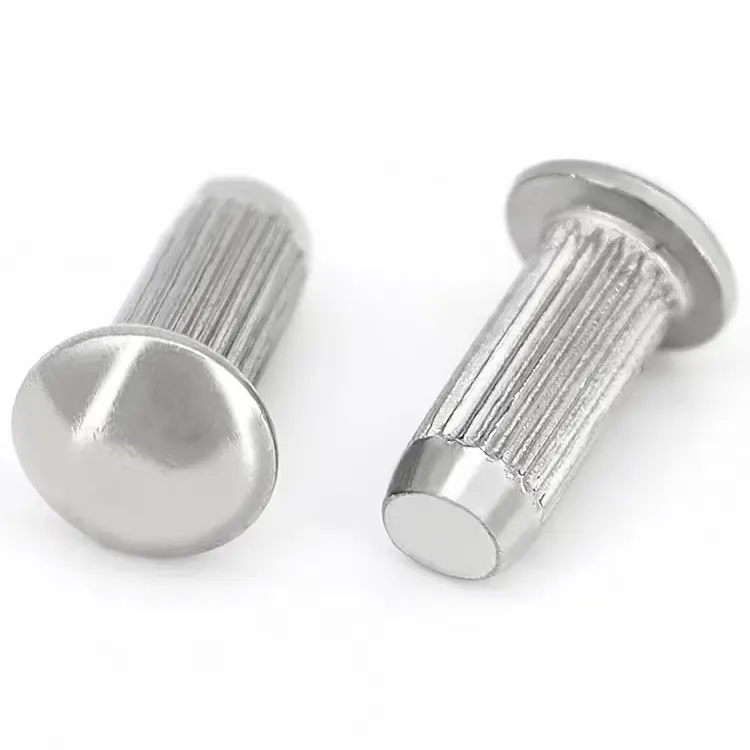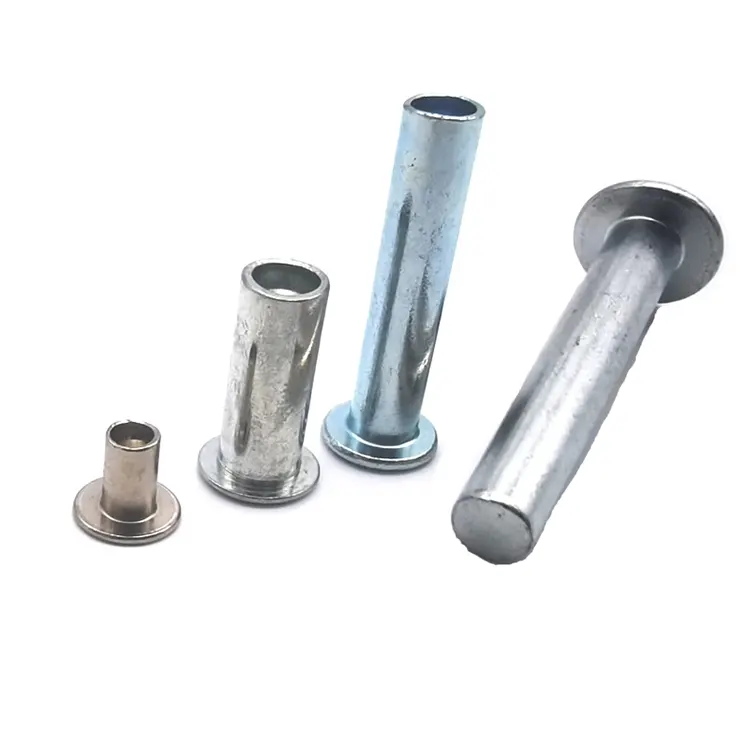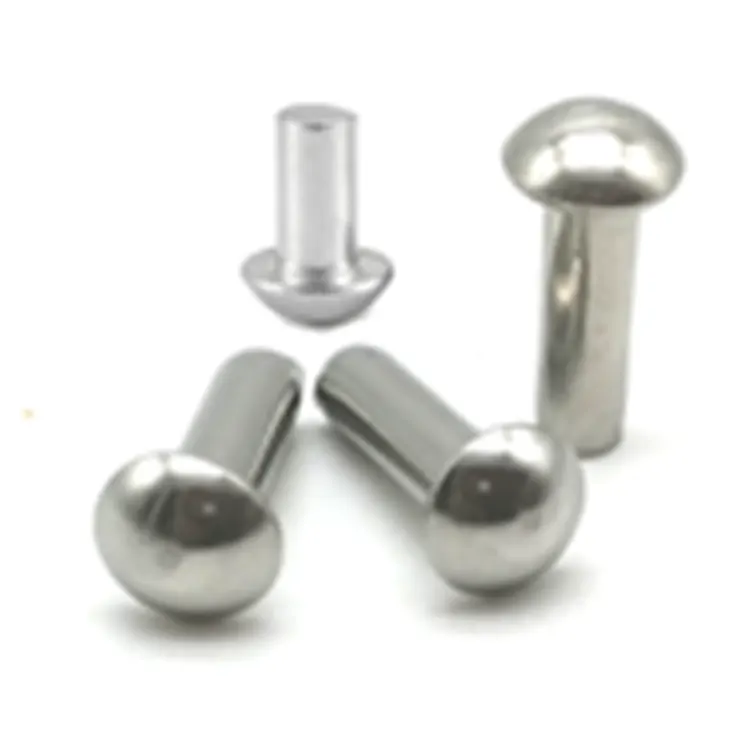Rivet
As one of professional manufacturer in China, Notin would like to provide you Rivets. And we will offer you the best after-sale service and timely delivery.
What is a rivet?
A rivet is a permanent mechanical fastener used to join two or more materials. Rivets work by inserting a metal pin into an aligned hole and deforming the end, creating a strong, secure, and durable connection. Unlike temporary fasteners like screws, rivets do not rely on threads, but instead form a permanent connection, making them ideal for applications requiring high strength, durability, and vibration resistance.
Classification of Rivets
Rivets are typically categorized by head shape, degree of hollowness, or material.
Based on head shape, rivets can be classified as flat head rivets, round head rivets, countersunk head rivets, mushroom head rivets, universal head rivets, truss head rivets, etc.

Based on degree of hollowness, rivets can be classified as solid rivets, semi-tubular rivets, or full tubular rivets.
Based on material, rivets can be classified as brass rivets, stainless steel rivets, steel rivets, aluminum rivets, copper rivets, etc.

What surface finishes are available for rivets?
Rivet surfaces are typically treated with rust-proofing treatments, primarily electroplating, including zinc plating, nickel plating, chrome plating, tin plating, gold plating, and silver plating. Electroplating is a common rust-proofing method for rivets. It applies a layer of plating to the rivet surface through physical or chemical methods. The plating effectively prevents corrosion and rust, while also providing a certain aesthetic effect.
Another special surface treatment method is head coating. Head coating is performed after the rivet is electroplated. This allows for a variety of colors on the rivet head, achieving an aesthetically pleasing finish.
Aluminum rivets cannot be electroplated, but they can be anodized. Anodizing also allows for a variety of color options, but the unit price is higher than electroplating.
Rust-proofing the rivet surface is crucial, effectively extending the rivet's service life and ensuring a secure connection. Different rust-proofing methods are suitable for different environments and applications, so the choice should be tailored to the specific situation.
- View as
Rivet wanita lelaki
Nuote Metals adalah pengeluar khusus lelaki rivet lelaki di China, kelebihan rivet wanita lelaki adalah pemasangan mudah dan kos rendah. Berbanding dengan kaedah sambungan lain, seperti kimpalan atau pelekat, rivet wanita lelaki tidak memerlukan kemahiran khusus atau masa pengawetan yang panjang. Walau bagaimanapun, kelemahan mereka juga penting: kekuatan sambungan adalah terhad, menjadikannya tidak sesuai untuk persekitaran intensiti tinggi atau tinggi. Selepas penggunaan jangka panjang, mereka mungkin longgar, memerlukan pemeriksaan biasa.
Baca LagiHantar PertanyaanRivet knurled
Rivet knurled biasanya terdiri daripada kepala, shank, dan ekor. Shank mempunyai corak knurled pepenjuru atau lurus, tekstur yang dimesin dan timbul yang memberikan cengkaman yang lebih baik semasa pemasangan dan menghalang alat slippage. Shank adalah silinder, dengan panjang dan diameter yang berbeza -beza bergantung kepada aplikasi. Saiz biasa berkisar antara 3 mm hingga 8 mm diameter dan 5 mm hingga 20 mm panjang. Ekor juga mungkin mempunyai benang atau alur untuk mengawan dengan kacang atau pengikat lain.
Baca LagiHantar PertanyaanRivet kepala bulat besi
Rivet kepala bulat besi adalah pengikat yang digunakan secara meluas dalam pembuatan industri dan kehidupan seharian. Reka bentuk unik mereka dan prestasi yang sangat baik menjadikan mereka pilihan utama dalam banyak bidang. Logam Nuote mengkhususkan diri dalam pengeluaran rivet kepala bulat besi. Dimensi rivet kami dengan ketat mematuhi toleransi yang dinyatakan pada lukisan pelanggan. Setiap proses adalah tertakluk kepada kitaran pemeriksaan kualiti untuk memastikan kualiti produk akhir. Kami mempunyai berpuluh -puluh mesin tajuk sejuk, dengan output harian puluhan juta rivet.
Baca LagiHantar PertanyaanRivet besi
Rivet besi, juga dikenali sebagaiRivet keluli karbon, adalah sejenis pengikat yang biasanya diperbuat daripada keluli karbon dengan rawatan permukaan seperti galvanizing. Mereka menawarkan kekuatan tegangan 400-500 MPa dan sesuai untuk aplikasi seperti peralatan elektrik. Untuk menampung pelbagai aplikasi yang memukau, rivet besi biasanya dihasilkan sebagai rivet separa kosong atau pepejal. Rivet besi adalah komponen mekanikal asas namun penting, digunakan secara meluas untuk kekuatan, kemampuan, dan kemudahan penggunaannya.
Baca LagiHantar PertanyaanRivet kepala kuali besi
Rivet kepala Iron Pan, dengan ciri-ciri ringan, tahan karat, dan estetika yang menyenangkan, telah menjadi serba boleh serba boleh dalam pembuatan perindustrian. Sama ada dalam aplikasi kritikal berat atau kehidupan seharian, rivet kepala pan besi menawarkan prestasi dan kebolehpercayaan yang luar biasa. Selamat datang ke logam Nuote di Dongguan, China, pakar dalam rivet ini. Kami menawarkan produk berkualiti tinggi dengan penghantaran yang dijamin. Kami juga mengeluarkan aksesori perkakasan lain, seperti kelopak mata, bahagian mesin, dan bahagian dicap.
Baca LagiHantar PertanyaanRivet kepala cendawan besi
Nuote Metals adalah pengeluar rivet profesional yang terletak di Dongguan, China. Rivet kepala cendawan besi kami, seperti namanya, menampilkan kepala berbentuk cendawan dengan sama ada teras separuh kosong atau pepejal. Kepala biasanya lebih besar, memberikan permukaan galas yang baik. Struktur ini membolehkan ubah bentuk semasa pemasangan, sama ada melalui penyemperitan atau perkakas khusus, untuk menghubungkan dua atau lebih bahan dengan selamat. Diperbuat daripada besi, mereka biasanya tergalvani atau dirawat dengan kemasan lain untuk rintangan kakisan.
Baca LagiHantar PertanyaanWhat are the advantages of rivets over other fasteners?
1. Ease of Installation
Rivets are fast to install, and even fully automated for high-volume applications, resulting in a simple and efficient operation process.
2. Connection Reliability
The riveting process is standardized, with strict quality control, resulting in highly stable connections. Visual inspection allows for quick verification of connection quality.
3. Vibration and Impact Resistance
Rivets connect through deformation or interference fit, providing strong clamping force and excellent vibration resistance, capable of withstanding vibration and shock.
4. Low Cost
Rivets are easy to install and can be fully automated, saving significant labor costs.
What are the advantages and disadvantages of rivets made of different materials?
Aluminum Rivets
Advantages: Lightweight, reduces overall product weight, low cost, suitable for general civilian applications.
Disadvantages: Low tensile and shear strength, unsuitable for high-strength workpieces, prone to electrochemical corrosion when in contact with metals such as stainless steel.
Stainless Steel Rivets
Advantages: Strong corrosion resistance, high hardness, suitable for high-strength workpieces (such as marine equipment)
Disadvantages: Higher cost, typically more expensive than aluminum rivets of the same specification.
Brass and Copper Rivets
Advantages: Excellent conductivity (such as connecting electronic components), good corrosion resistance.
Disadvantages: Higher cost, more difficult to process.
Steel Rivets
Advantages: High hardness, high connection reliability, and wide applicability.
Disadvantages: Compared to other materials, iron rivets are more prone to rusting.
What are the main applications of rivets?
Rivets have a wide range of uses, from small items like a pair of scissors to large items like airplanes and ships, as well as in high-precision medical applications.
Industrial Manufacturing
Rivets are used in a wide variety of industrial fields, wherever there is a need to connect two or more materials.
Electronics
Rivets secure heat sinks and chips, providing both vibration damping and noise reduction, and are widely used in the cooling systems of electronic products such as computers and mobile phones.
Automotive
Rivets are widely used to connect components of automobile bodies and chassis, such as doors and hoods. Their lightweight and corrosion-resistant properties make them an indispensable joining method in automotive manufacturing.
Aerospace
In aircraft manufacturing, rivets are used to connect different fuselage components, such as wings and tailplanes. Millions of rivets create high-strength, corrosion-resistant joints. Aluminum and titanium alloy rivets are often used to connect components of corresponding materials, ensuring stability in extreme environments.
Rivets are used everywhere. The above examples only represent a small number of their applications. We see rivets everywhere in our daily lives, such as on scissors, folding beds, and strollers etc. Rivets can be customized to different sizes and materials depending on the application.
Nuote Metals has specialized in the rivet industry for over a decade. Our factory is located in Dongguan, a city known as the "World Factory," a city with a developed industry and convenient transportation. This allows us to respond quickly when acquiring raw materials and supporting surface treatments, meeting our customers' needs for quick access to samples and bulk orders. We produce 10 million rivets daily and have molds of various specifications, allowing us to produce rivets as small as 0.8mm and as large as 10mm. We welcome your inquiries and visits.

